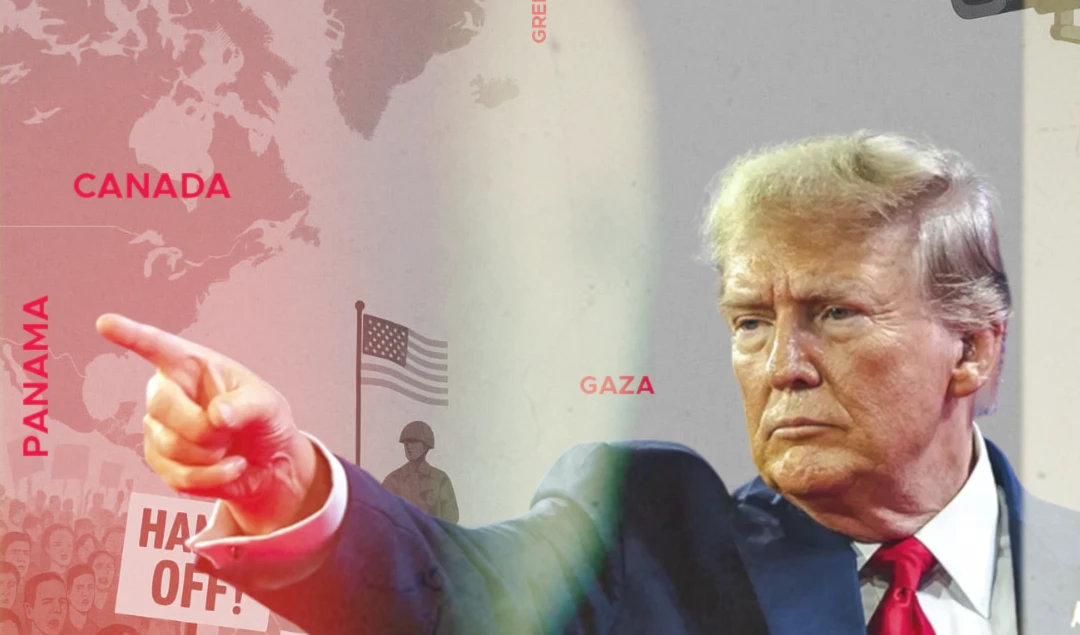Why Trump’s Panama Canal threats don’t add up.
The Trump administration’s aggressive rhetoric about Chinese influence in Panama is a cover for pressuring the country to cede greater control over the Panama Canal, with Washington’s real aim being to reassert US dominance at the expense of Panama’s autonomy and international partnerships.
-

First, the rhetoric surrounding so-called ‘Chinese influence’ on the Canal is devoid of tangible proof (Illustrated by Mahdi Rteil to Al Mayadeen English)
US President Donald Trump appears to take Panama’s ownership and administration of the Panama Canal for granted. The latest cover for Washington’s pressure tactics is so-called ‘Chinese influence,’ which the United States continues to assert without convincing evidence. "Today, the Panama Canal faces ongoing threats," said Defense Secretary Pete Hegseth recently. "The United States of America will not allow communist China or any other country to threaten the canal's operation or integrity," he added. There is good reason to believe that the US poses the greatest threat to the Canal’s operations and integrity. Here is why.
First, the rhetoric surrounding so-called ‘Chinese influence’ on the Canal is devoid of tangible proof. The Trump administration has chosen to amplify these threats so that it can win confidence with Panama City, but ground realities cannot be hidden under the carpet. Look no further than Trump’s own inaugural address in January 2025: he asserted that the Panama Canal had been “foolishly” given to the country, recalling scores of so-called US sacrifices that pale in comparison to US-sponsored massacres as far as Gaza.
It is thus understood that scapegoating China to court Panama shouldn’t come off as a surprise. There is a degree of racism in Washington’s approach to Beijing, given Defense Secretary Pete Hegseth’s characterization of so-called Chinese actions as “Communist” and against the interests of the Central American state. In reality, the United States is openly threatening the use of “deadly military force” to ensure the Canal’s access to all countries around the world. But make no mistake, the Trump administration is the biggest impediment to free and unmitigated trade world-over: it shows in its reckless spike in duties, and desire to hold the liberal trade order hostage. Washington’s Canal threats should thus be seen as an extension of this aggressive posturing, which assumes actions in the interests of Panama when the reality is much different.
What has Panama been forced to do so far: Trump’s repeated threats have compelled it to increase pressure on Panama Ports’ parent company to exit the nation. And US pressure was also a factor in undermining Panama’s independent ties with China as well. Ill-intent was evident by February, when Washington stepped up pressure on Panama to end its involvement in China’s Belt and Road Initiative (BRI). Washington has a vested stake in undermining the BRI, and presenting its proximity to Panama as an excuse to take back the Canal. Panama will thus be well-advised to heed these signs and see through the Trump administration’s campaign to present the Canal takeover as a domestic win.
Evidence proves this point. Chinese port management companies operating in Panama have been functional in the country for many decades and do not qualify as a threat to the Canal. Associated facilities are also run by enterprises beyond China, weakening Washington’s claims that Chinese access to ports is a threat to US interests. For Panama, the issue is straightforward: Washington is deliberately questioning its well-established control of the Canal to justify US overreach. Despite Panama resisting Trump’s assertions of unwanted Chinese influence, Washington shows few signs of dialing down the pressure on Panama – a country whose interests it claims to protect.
The alarm bells are ringing. US-China competition, spearheaded by the US, shows no signs of dialing down as Trump makes it his personal imperative to bring China to heel. Given Beijing’s indispensability to international trade, its linkages with countries world over – including Panama – and its status as a major competitor to the US, Trump’s obsession will prove counterproductive. Given the futility of Trump’s confrontational attitude towards China, it is clear that the US is using the US-China binary to easily weaken Panama’s authority over the Canal. Though Panama refuses to let this happen, Trump will continue to play-up the China factor to silently damage Panama’s interests and undermine its autonomy. This is dangerous and deliberate scheming on full display.
Having illusions about actual US intent would do Panama no favors either. As early as March, the Pentagon reportedly contemplated military options to acquire access to the Canal, and Panama demonstrated strong resolve in defending its territorial autonomy. Taking the Canal by force was a possible option, and Trump has shown blatant disregard for Panama’s sensitivities by claiming to Congress that his administration “will be reclaiming the Panama Canal, and we’ve already started doing it.”
This line of attack runs counter to pronouncements of joint cooperation with Panama, serving as an eye opener for the Central Asian state to place its bets carefully. How the US takes the Canal or is able to proceed with its threats is immaterial: the line of attack has cost Panama some of its economic interests with a key Asian partner, in part due to Washington’s attempts to ensure it.
This tells us everything about the actual US intent on the Canal, and the falsehoods touted to cover it up. Trump’s Canal threats are not about Chinese influence – they are about pressing Panama to ensure it follows US dictates.

 Hannan Hussain
Hannan Hussain
 5 Min Read
5 Min Read










